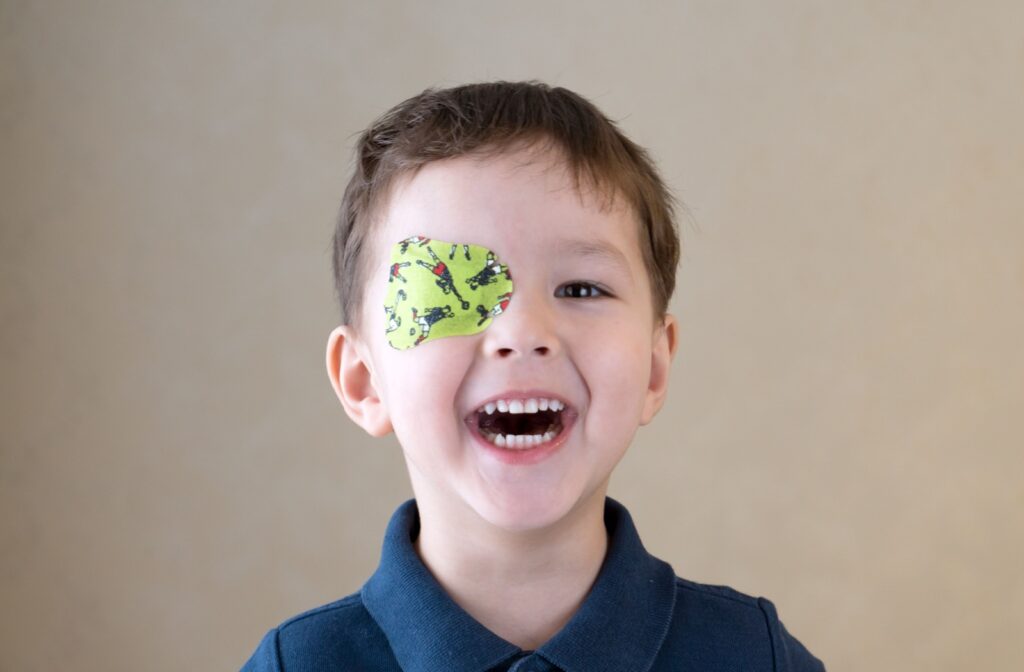Strabismus, commonly known as “lazy eye,” is a condition where the eyes aren’t properly aligned and don’t always look in the same direction. One or both eyes may turn inward, outward, upward, or downward, especially when focusing. While it may be especially noticeable in babies or toddlers, strabismus can also develop later in childhood or even adulthood.
If someone in your family has strabismus, it’s natural to wonder if it’s passed down through genetics. Genetics can play a role in strabismus, but it’s not the only factor.
Understanding how strabismus develops, as well as the importance of early eye exams, can help families take the right steps to support healthy visual development.
Understanding What Causes Strabismus
Strabismus is a condition in which the eyes do not align properly or move together in a coordinated way. While it may appear to be caused by problems with the eye muscles, it more commonly results from issues with the brain’s control of eye movement or the nerves that communicate with the muscles.
In many cases, the eyes are structurally normal, but the neurological control needed for coordinated eye alignment is disrupted, preventing them from working together as a team.
Strabismus in Children
In children, strabismus may be present from birth or appear within the first few years of life. Sometimes, it’s constant; other times, it only happens when the child is tired, sick, or focusing on something up close.
This condition can affect depth perception and may lead to amblyopia, where one eye becomes weaker because the brain starts to ignore its input. That’s why early diagnosis and treatment are so important, especially while a child’s visual system is still developing.
The Genetic Connection
There is often a genetic component to strabismus. If a parent or sibling has the condition, a child has an increased risk of developing it as well. However, genetics doesn’t act alone. Just because someone has a family history doesn’t mean that they’ll develop the condition themselves. In fact, strabismus can occur in children with no family history at all.
Some key genetic links to keep in mind include:
- A higher chance of developing strabismus when a close relative has it
- Associated genetic or developmental conditions like Down syndrome or cerebral palsy
- Family history of eye muscle or nerve abnormalities
Genetic predisposition is one piece of the puzzle. The way a child’s eyes and brain develop, along with other physical and neurological factors, also play a major role in whether or not they develop strabismus.
Other Factors That May Contribute to Strabismus
Outside of genetics, a number of conditions and experiences can contribute to strabismus and amblyopia in children:
- High levels of uncorrected farsightedness and astigmatism
- Being born prematurely
- High levels of uncorrected farsightedness
- Brain injuries or infections during infancy
- Neurological or developmental disorders
- Significant eye trauma or head injury
Some children may also cross their eyes when trying to focus, especially if they’re farsighted and their eyes are working overtime to see clearly up close.
Why Early Childhood Eye Exams Matter
Early and comprehensive eye exams are one of the best ways to catch strabismus and amblyopia before they begin to affect a child’s development. While pediatricians or school screenings may check for obvious vision issues, they don’t assess how well the eyes are working together or pick up on subtle signs of misalignment.
A full children’s eye exam will typically include:
- Eye muscle testing to look for signs of misalignment
- Visual acuity testing to detect amblyopia or blurry vision
- A dilated eye exam to examine the internal eye structures
- Discussion of eye tracking, focus, and binocular coordination
At Visionary Eye Care, we offer specialized infant screenings through the InfantSEE® program, a public health initiative from the American Optometric Association (AOA) that provides no-cost vision assessments for babies 6 to 12 months old.
If no concerns are found during the InfantSEE screening, we recommend beginning yearly comprehensive eye exams at age 2 to 3 years old. However, if parents notice signs of strabismus or any eye turn at any age, an earlier visit is always appropriate.
Symptoms Parents Should Watch For
Although strabismus is sometimes obvious, subtle signs might be missed without an exam. Parents and caregivers can look for things like:
- One eye that seems to drift or wander
- Consistently closing one eye or the other
- Consistent and frequent rubbing of one eye or the other
- Frequent squinting or head tilting
- Complaints of double vision or trouble focusing
- Covering one eye while reading or watching something
- Difficulty with depth perception or clumsiness
- Consistent and frequent blinking
Kids don’t always know how to describe vision problems, which makes regular exams a key part of protecting their eye health.
Treatment Options for Strabismus in Children

When strabismus is diagnosed early, there are more options to guide healthy visual development and avoid long-term problems like amblyopia. Treatment is tailored based on the child’s age, the severity of the misalignment, and whether there are other vision concerns involved.
Common treatment strategies include:
- Eyeglasses: Often used if the child has significant refractive errors (e.g., nearsightedness, farsightedness, or astigmatism) that contribute to their eye turn.
- Luminopia therapy: A digital treatment that uses a virtual reality headset to encourage the brain to use input from the weaker eye. It offers an engaging alternative to traditional eye patching.
- Patching therapy: In cases where amblyopia is also present, a patch can be worn over the stronger eye to help the weaker eye develop.
- Vision therapy: A series of guided exercises designed to improve eye coordination and communication with the brain.
- Surgical treatment: In some cases, eye muscle surgery may be recommended to realign the eyes.
Vision therapy is often used alongside glasses or patching and focuses on training the eyes to work together more effectively. Many children respond well to this approach, especially when therapy starts early.
Supporting Your Child’s Visual Journey
When it comes to vision, early support can make all the difference. Even if strabismus has a genetic link, a proactive approach to diagnosis and care can help your child build strong visual skills and confidence. At Visionary Eye Care, we take a family-focused approach to eye health that’s modern, playful, and rooted in comprehensive care. Our team helps guide parents through diagnosis and treatment, with solutions designed to grow alongside your child. If you’ve noticed signs of eye misalignment or if strabismus runs in your family, give us a visit. We’re here to help every step of the way.



